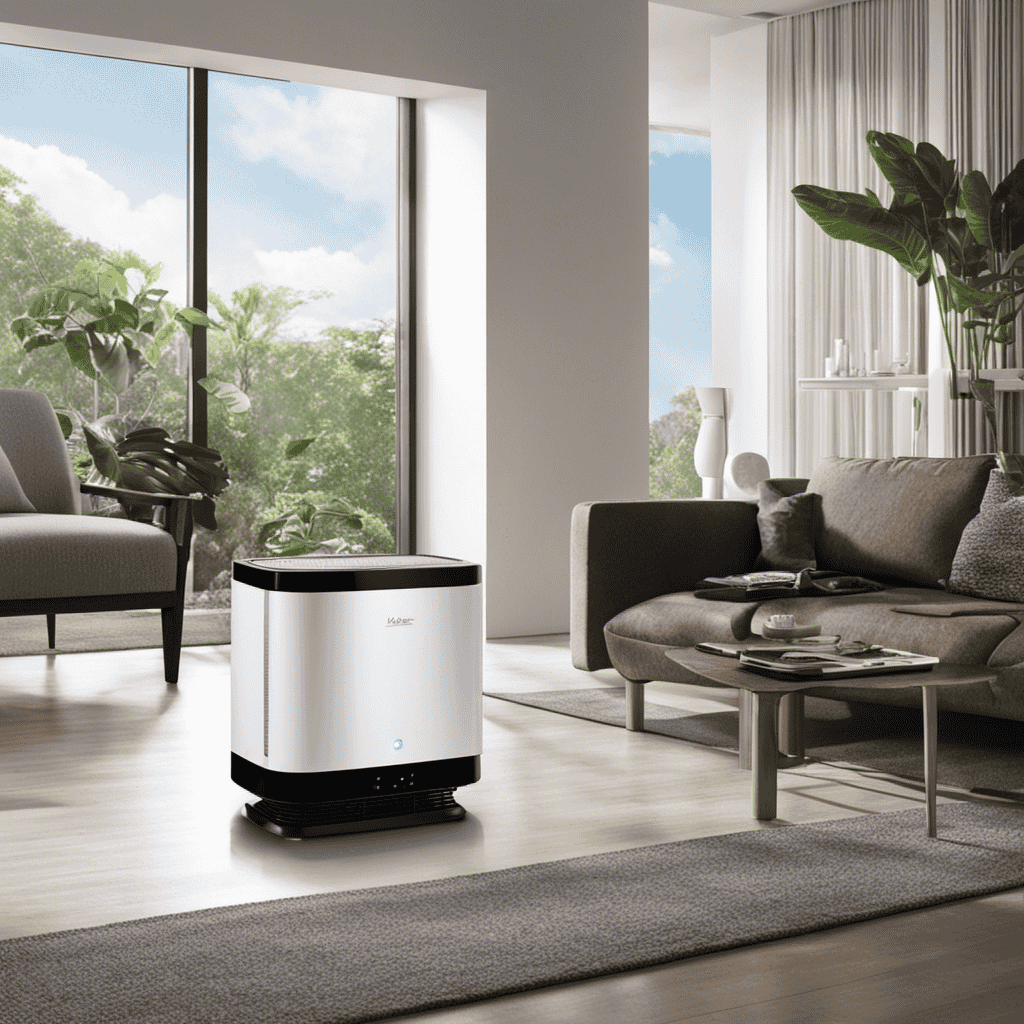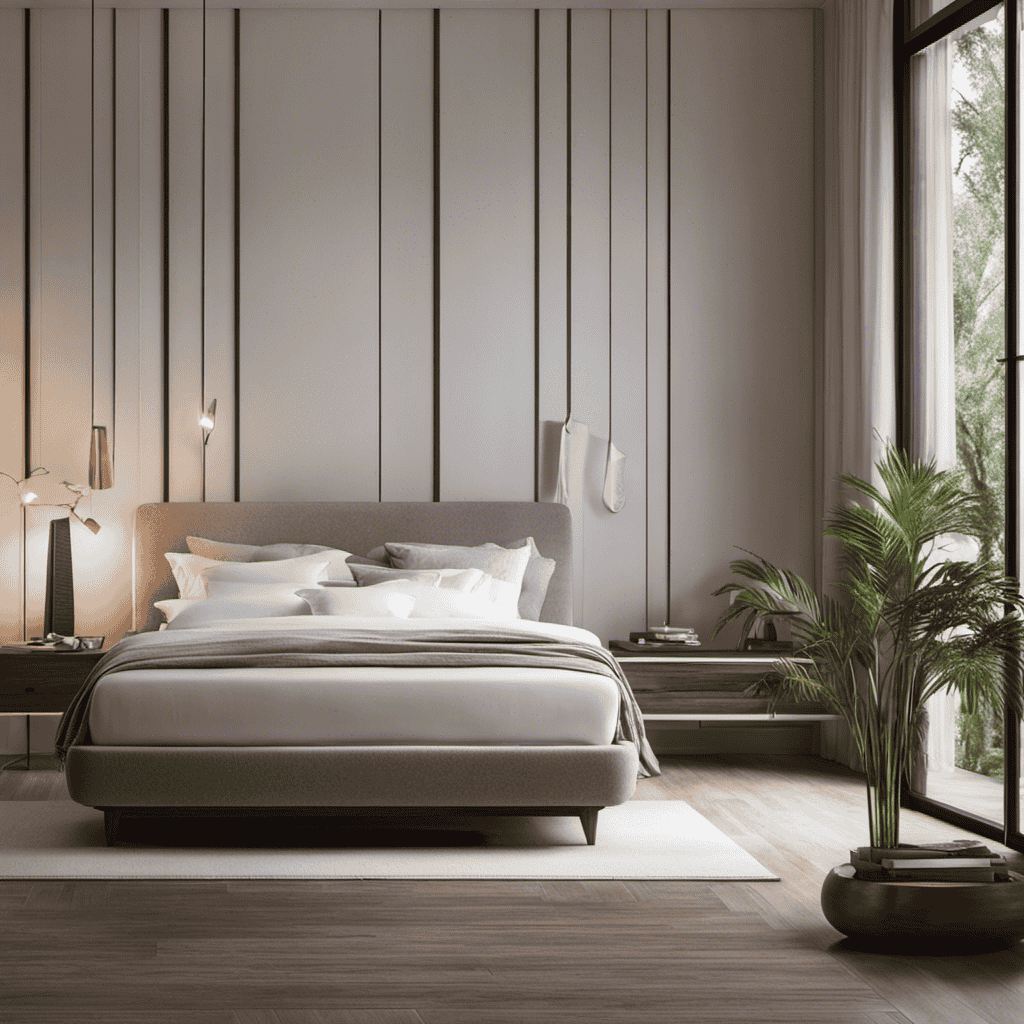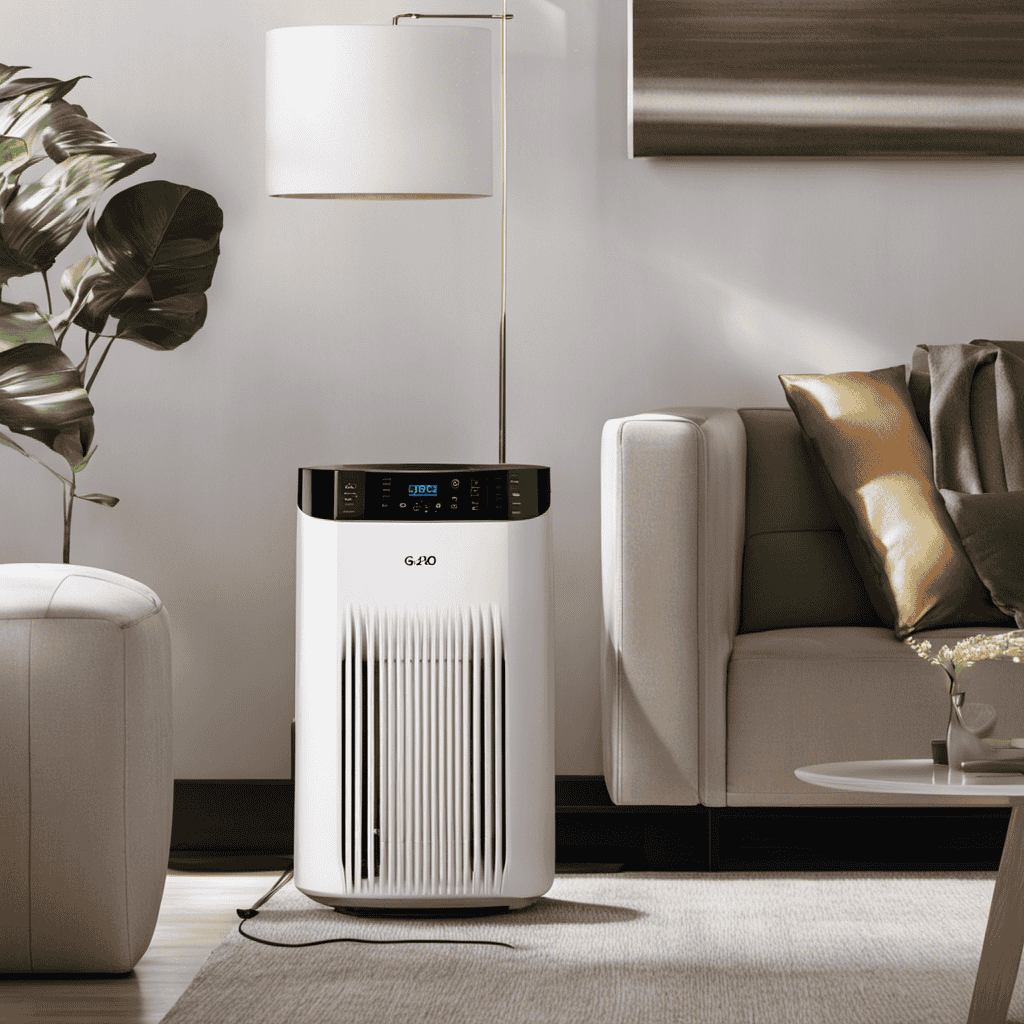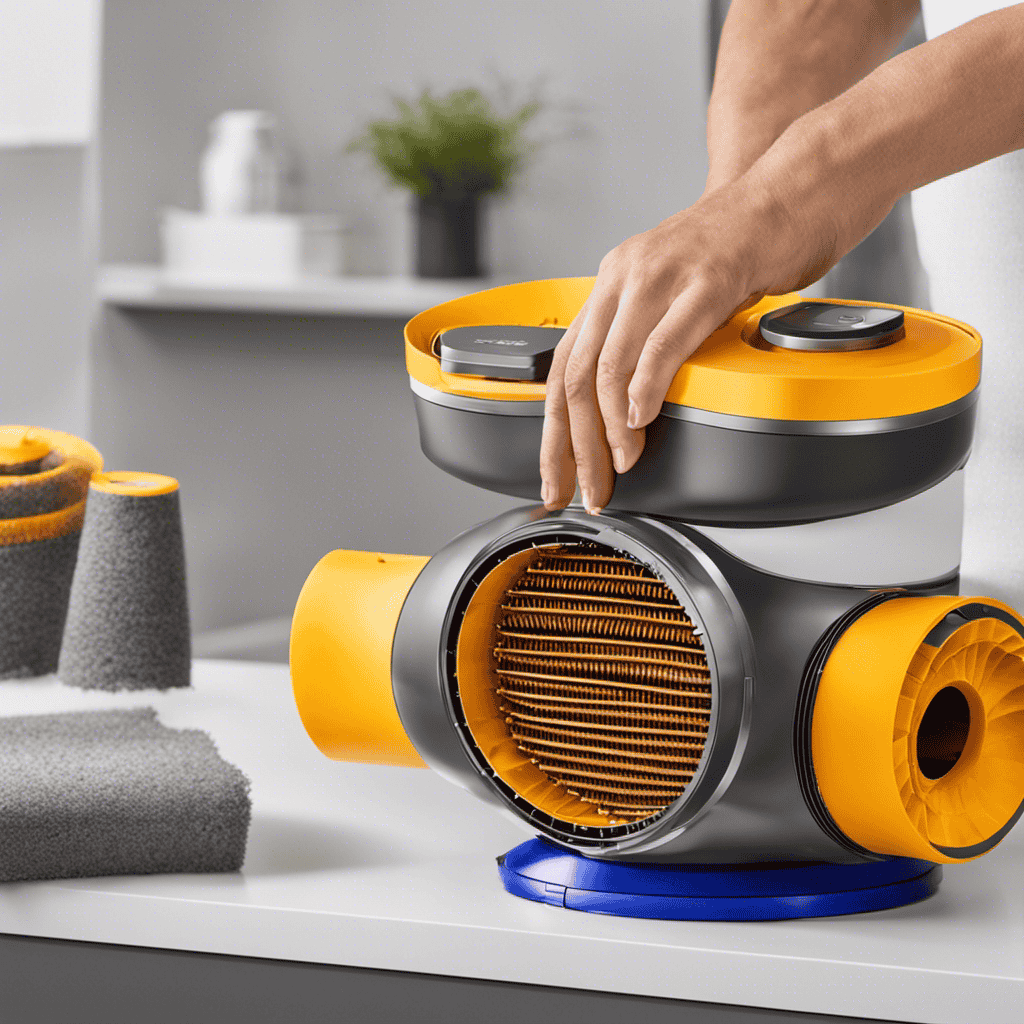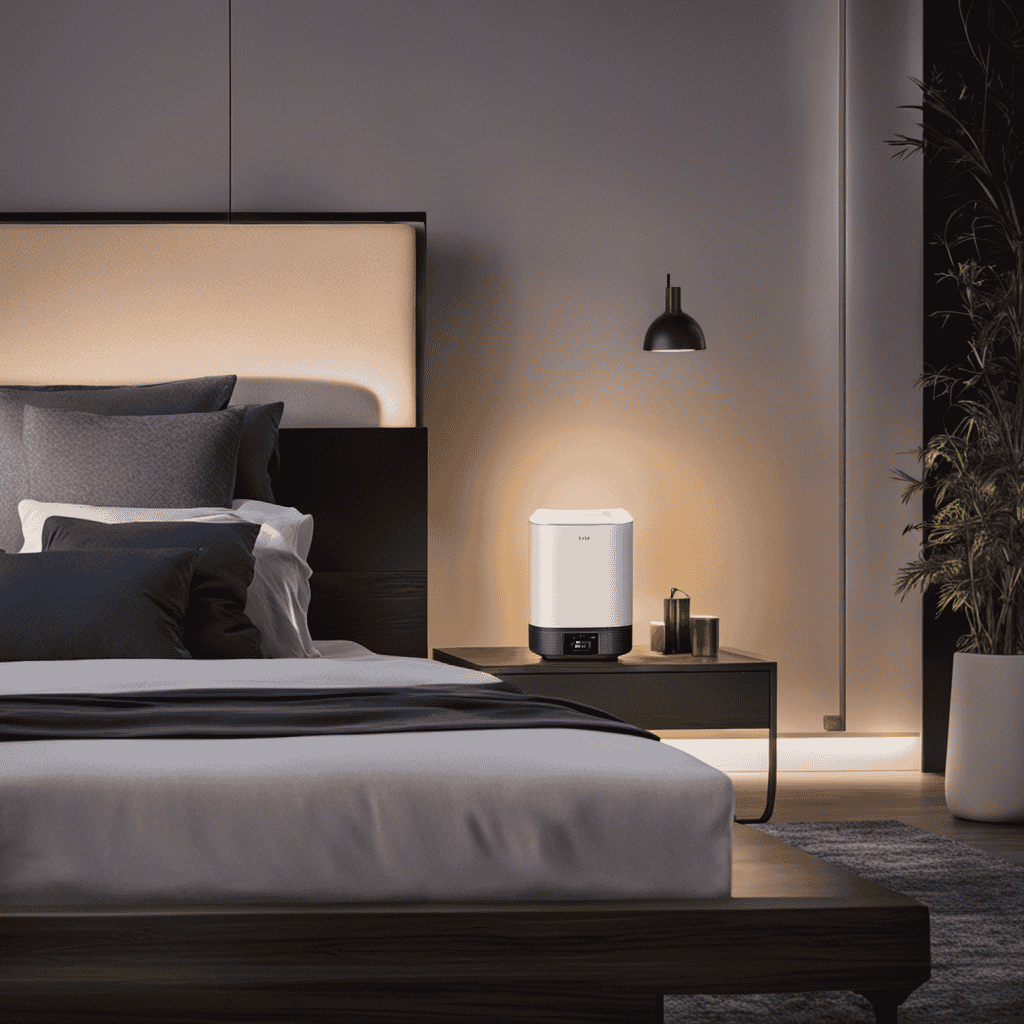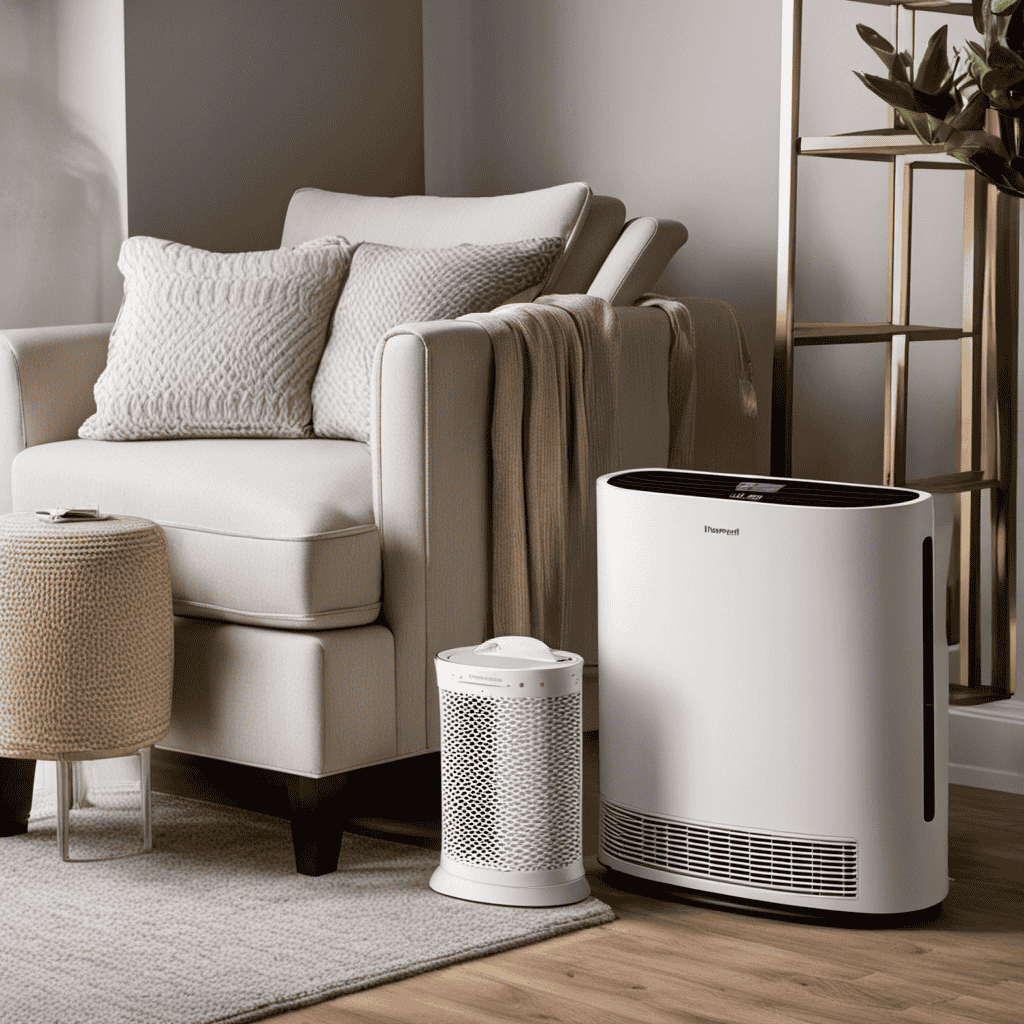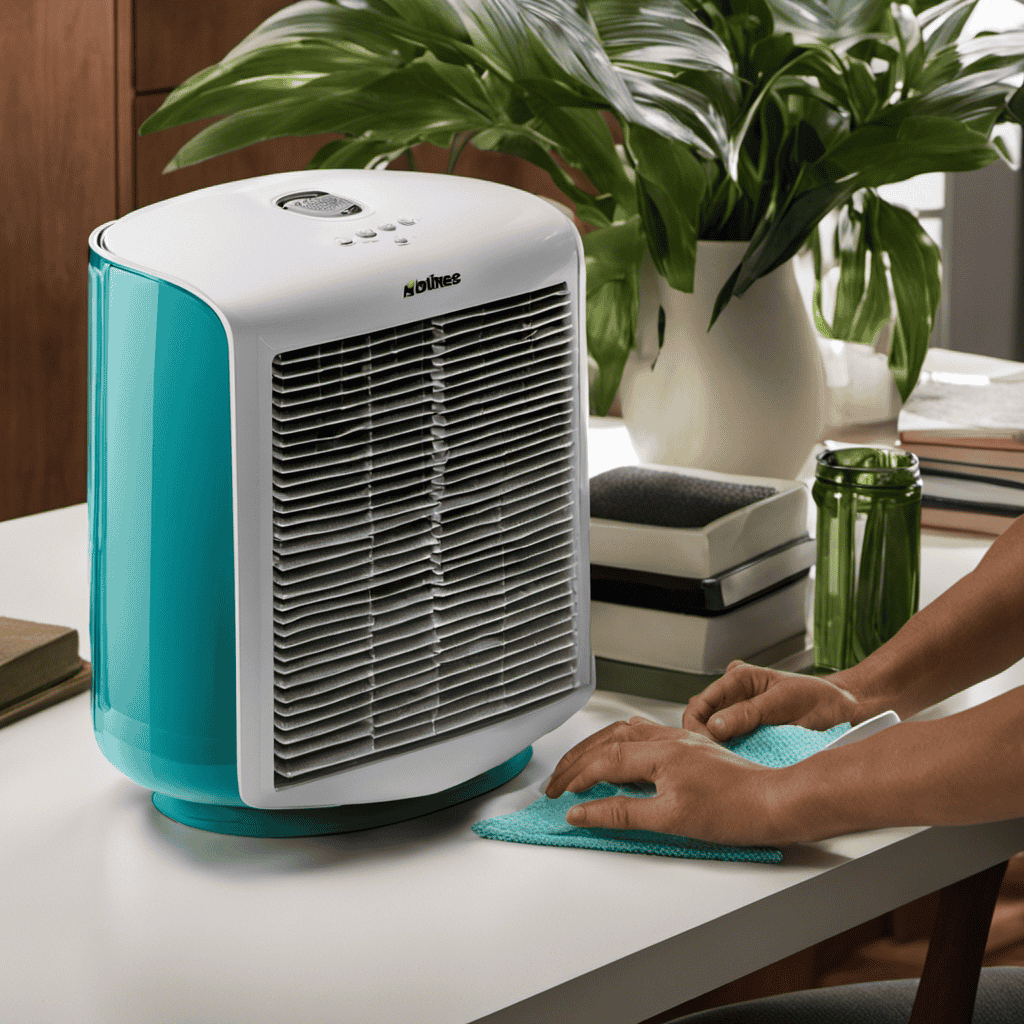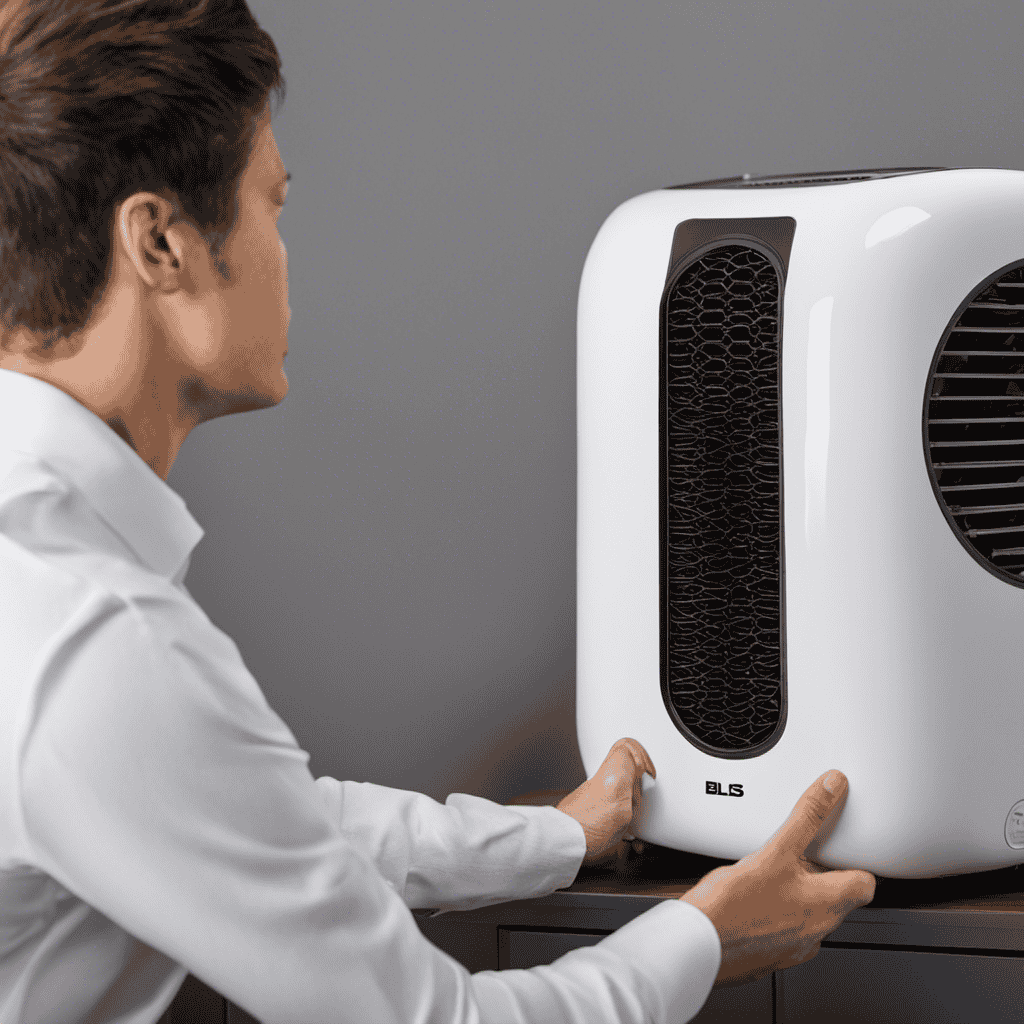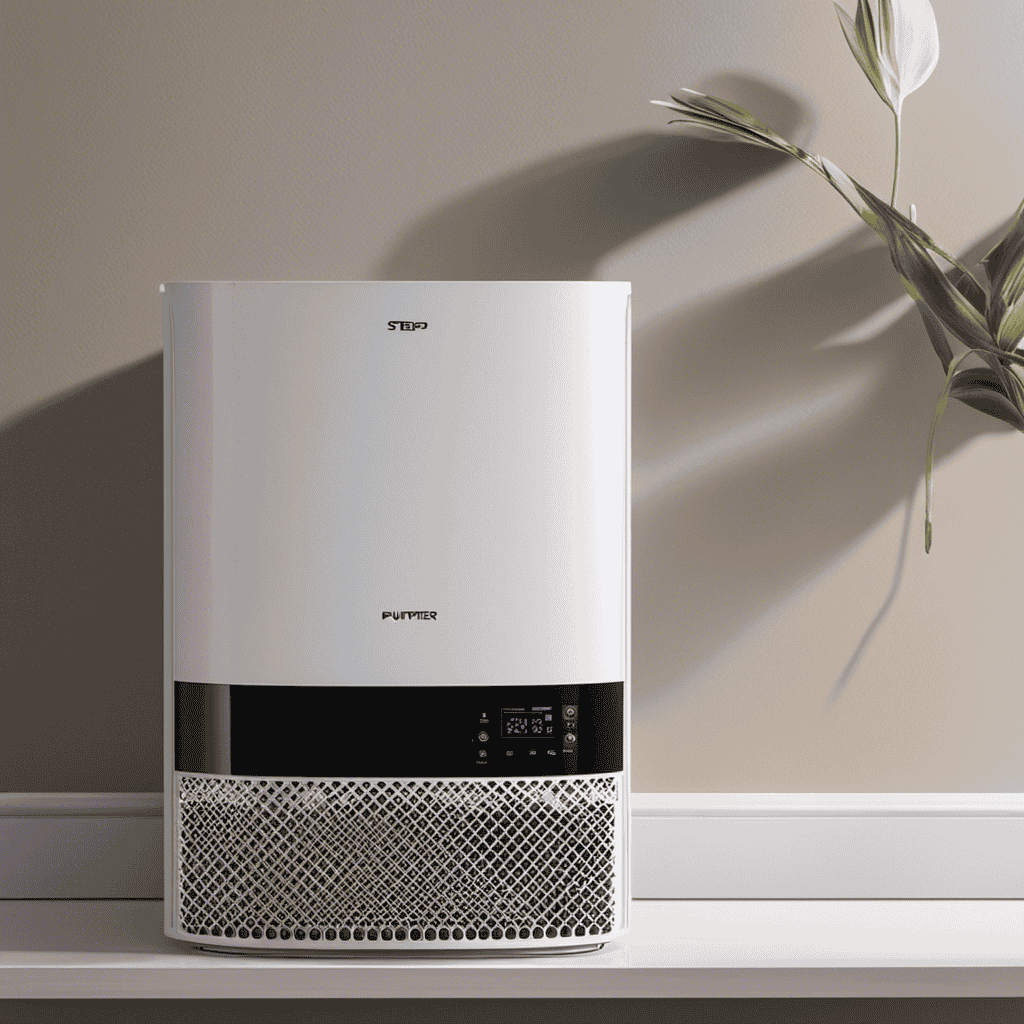Have you ever been curious about the functionality of an air purifier ionizer? Allow me to enlighten you on this intriguing technology.
An air purifier ionizer is a device that improves your indoor air quality by removing pollutants and allergens. It works by releasing negatively charged ions into the air, which attach to positively charged particles, causing them to become heavy and fall to the ground.
In this article, we will delve into the health benefits, functioning, and misconceptions surrounding air purifier ionizers, as well as provide tips for maintenance and maximizing their effectiveness.
Key Takeaways
- Air purifier ionizers remove harmful particles from the air, improving indoor air quality.
- They help alleviate allergies and asthma symptoms, as well as reducing the presence of allergens, pollutants, and irritants.
- Air purifier ionizers create a healthier and more comfortable environment by reducing harmful bacteria and viruses in the air.
- Additionally, they have positive effects on mental health and sleep quality, reducing stress, anxiety, and improving mood.
Health Benefits of an Air Purifier Ionizer
An air purifier ionizer can help improve your health by removing harmful particles from the air you breathe. Negative ions are generated by the ionizer, which attach themselves to airborne particles, making them heavy and causing them to fall to the ground. This process effectively reduces the presence of allergens, pollutants, and irritants in your indoor environment.
Beyond physical health benefits, negative ions have also been shown to have positive effects on mental health. They can enhance mood, reduce stress, and improve overall well-being.
Additionally, air purifier ionizers are beneficial for pet owners. They effectively remove pet dander, hair, and odors, ensuring a cleaner and healthier living space for both you and your furry friends.
How Does an Air Purifier Ionizer Work
In this discussion, I’ll explain the ionization process used in air purifier ionizers and highlight their benefits.
I’ll also compare ionizers to filters, examining their respective advantages and limitations.
Ionization Process Explained
Understanding how the ionization process works in an air purifier ionizer is essential to effectively clean the air in your home. Ionization technology plays a crucial role in improving indoor air quality.
The process involves emitting negatively charged ions into the air, which then attach to airborne particles, such as dust, pollen, and pet dander. These negatively charged ions neutralize the positive charges on these particles, causing them to clump together and fall out of the air. This process effectively removes these harmful particles from the air you breathe, leading to numerous benefits.
Negative ion benefits include reducing allergies and asthma symptoms, improving mood and mental clarity, and eliminating odors. By understanding the ionization process, you can make informed decisions when choosing an air purifier ionizer for your home.
Benefits of Ionizers
Using an ionizer can provide multiple benefits. It can help alleviate allergies and asthma symptoms, improve mood and mental clarity, and eliminate odors. Ionizers emit negative ions into the air, which attach themselves to airborne particles. This makes the particles too heavy to remain airborne, causing them to fall to the ground or be easily captured by a filter. The negative ions also have a positive effect on our bodies. They increase the flow of oxygen to the brain and promote the release of serotonin, which helps improve mood and mental clarity. Additionally, negative ions reduce the presence of harmful bacteria and viruses in the air, enhancing air purification. By incorporating an ionizer into your home or office, you can create a healthier and more comfortable environment.
In the subsequent section, we will compare ionizers to filters to help you make an informed decision about which option is best for your needs.
Comparing Ionizers to Filters
When comparing ionizers to filters, it’s important to consider their effectiveness in removing airborne particles. While both devices aim to improve indoor air quality, they do so in different ways. Here are some key points to consider:
-
Ionizers:
-
Release negative ions that attach to airborne particles, making them heavier and causing them to settle.
-
Can remove particles as small as 0.01 microns, including allergens like pollen, dust mites, and pet dander.
-
Help reduce allergy symptoms by capturing and removing allergens from the air.
-
Filters:
-
Use a physical barrier to trap particles as air passes through the device.
-
Can remove larger particles like dust and pet hair, but may not be as effective at capturing smaller allergens.
-
Require regular maintenance and filter replacement to maintain their effectiveness.
Understanding the Ionization Process
To better understand how an air purifier ionizer works, let me explain the process of ionization.
Ionization is the process by which an air purifier ionizer charges particles in the air, creating negative ions. These ions attach themselves to airborne particles, such as dust, pollen, and pet dander. The charged particles then become heavier and settle, effectively removing them from the air.
This process has several benefits. Firstly, it helps to reduce allergens and irritants in the air, which can improve indoor air quality and alleviate symptoms for those with allergies or respiratory conditions. Additionally, ionization can also neutralize odors and eliminate harmful bacteria and viruses.
However, it is important to note that ionization does not remove these particles from the air entirely, but rather causes them to settle on surfaces. This is where the next section, about removing pollutants with an air purifier ionizer, comes in.
Removing Pollutants With an Air Purifier Ionizer
Now that we understand the ionization process, let’s explore the benefits of using an air purifier ionizer. This innovative technology offers several advantages in improving indoor air quality.
Here are some key benefits of air purifier ionizers:
-
Eliminates airborne pollutants: Air purifier ionizers release negatively charged ions that attach to airborne pollutants like dust, pollen, and pet dander, causing them to fall to the ground and be removed from the air.
-
Reduces odors: Ionizers are effective at neutralizing unpleasant odors by breaking down odor-causing molecules in the air.
-
Kills bacteria and viruses: The negative ions produced by ionizers can also eliminate harmful microorganisms, such as bacteria and viruses, by disrupting their cellular structure.
Air purifier ionizers provide an efficient and effective way to remove pollutants from the air, improving overall air quality and creating a healthier indoor environment.
The Role of Negative Ions in Air Purification
When it comes to air purification, understanding the role of negative ions is crucial. Negative ions are known to have the ability to attract and neutralize pollutants in the air, effectively removing them from our environment.
Not only do negative ions help eliminate harmful particles, but they also offer numerous health benefits. These benefits include reducing stress, improving mood, and boosting overall well-being.
Ionizers, which emit negative ions into the air, are a popular choice for achieving cleaner and healthier indoor air.
Negative Ions and Pollutants
Negative ions in the air purifier ionizer help attract and remove pollutants from the air. These tiny, negatively charged particles, generated by the ionizer, effectively improve the air quality.
Here are some key points to understand the relationship between negative ions and pollutants:
-
Negative ions attach themselves to airborne pollutants, such as dust, allergens, and smoke particles.
-
This process makes the pollutants heavier, causing them to fall to the ground or stick to surfaces, reducing their presence in the air we breathe.
-
By removing these pollutants, negative ions contribute to better indoor air quality. This improvement can have significant health benefits, especially for those with respiratory issues or allergies.
Health Benefits of Ions
The presence of negative ions in the air can contribute to improved health and well-being. Ionizers, devices that release negative ions into the air, have been found to have positive effects on mental health and sleep quality. Negative ions can help reduce stress and anxiety, improve mood, and increase focus and concentration. They can also promote better sleep by creating a calming and relaxing environment. Research has shown that negative ions have the ability to increase the production of serotonin, a neurotransmitter that plays a crucial role in regulating mood and sleep. In addition, negative ions can help purify the air by neutralizing harmful pollutants and allergens. Incorporating an ionizer into your home or workplace can have significant benefits for your mental and physical well-being.
| Mental Health Benefits | Sleep Quality Benefits | Air Purification Benefits |
|---|---|---|
| Reduces stress and anxiety | Promotes better sleep | Neutralizes harmful pollutants |
| Improves mood | Creates a calming environment | Removes allergens |
| Increases focus and concentration | Enhances relaxation | Purifies the air |
Ionizers for Clean Air
If you want cleaner air in your living or working space, consider incorporating an ionizer. These devices are designed to purify the air by releasing negative ions, which attach themselves to dust, pollen, and other pollutants, causing them to become heavy and fall to the ground.
Here are three key benefits of using an ionizer:
-
Improved Mental Health: Studies have shown that negative ions can have a positive impact on mental health. They can help reduce stress, improve mood, and increase focus and productivity.
-
Reduction of Pet Dander: If you have pets, you know how difficult it can be to keep their dander under control. Ionizers can effectively remove pet dander from the air, making it easier for allergy sufferers to breathe.
-
Odor Elimination: Ionizers can also help eliminate unpleasant odors in your space. Whether it’s from cooking, smoking, or other sources, the negative ions neutralize the odor-causing particles, leaving the air fresh and clean.
Can an Air Purifier Ionizer Improve Air Quality
An air purifier ionizer can definitely improve air quality in your home. By releasing negative ions into the air, an ionizer helps to remove pollutants and allergens, making the air cleaner and healthier to breathe. But did you know that ionizers can also have a positive impact on your mental health? Studies have shown that negative ions have mood-enhancing effects, helping to reduce stress, anxiety, and depression. This makes ionizers a great addition to the workplace as well, where high levels of stress and tension can be common. In fact, many companies have started using ionizers in their offices to create a more peaceful and productive environment.
| Benefits of Ionizers in the Workplace |
|---|
| Improved air quality |
| Reduced stress and anxiety |
| Increased productivity |
Reducing Allergens With an Air Purifier Ionizer
In this discussion, we will delve into the effectiveness of ionizers and the health benefits they offer.
Ionizers are known for their ability to improve indoor air quality by removing harmful particles and allergens from the air.
Understanding the effectiveness of ionizers and the positive impact they can have on our health is crucial in making informed decisions about air purifiers.
Effectiveness of Ionizers
The effectiveness of ionizers is often debated among experts in the field. While they are designed to improve air quality by producing negative ions that attach to airborne particles, there are potential side effects to consider.
Here are some key points to keep in mind:
- Ionizers can help reduce allergens, such as dust, pollen, and pet dander, in the air.
- They can also neutralize odors by attaching to odor-causing molecules and making them heavier, causing them to fall to the ground.
- However, ionizers may produce ozone as a byproduct, which can be harmful to human health, especially for those with respiratory conditions.
It is important to consider the pros and cons of ionizers before deciding to use them. While they can be effective in improving air quality, potential side effects should not be ignored.
Health Benefits of Ionizers
To fully understand the health benefits of ionizers, you should consider how they can potentially improve your overall well-being.
Ionizers have been shown to have positive effects on mental health, promoting a sense of calm and relaxation. By releasing negative ions into the air, ionizers help to balance serotonin levels in the brain, which can alleviate symptoms of depression and anxiety.
In workplace environments, ionizers can be especially beneficial. They can reduce stress levels and improve focus, leading to increased productivity and efficiency.
Additionally, ionizers can help to purify the air by removing pollutants and allergens, creating a healthier and more comfortable working environment.
Overall, incorporating ionizers into both personal and professional spaces can have significant positive impacts on mental health and overall wellness.
Removing Odors With an Air Purifier Ionizer
Did you know that an air purifier ionizer can help eliminate unwanted odors in your home? With its advanced technology, an air purifier ionizer can effectively remove odors caused by cooking, pets, smoke, and other sources.
Here are some key benefits of using an air purifier ionizer:
-
Improved air quality: An air purifier ionizer releases negatively charged ions into the air, which attach themselves to airborne particles and remove them from the environment. This process helps to eliminate odors and improve the overall air quality in your home.
-
Odor neutralization: The ionization process breaks down odor-causing molecules, neutralizing the smells and leaving your home smelling fresh and clean.
-
Chemical-free solution: Unlike air fresheners or sprays that mask odors with chemicals, an air purifier ionizer provides a natural and chemical-free solution to eliminating odors.
With its many benefits, an air purifier ionizer is a valuable addition to any home, ensuring a clean and odor-free environment.
How an Air Purifier Ionizer Helps With Respiratory Issues
As an expert on air purifier ionizers, I want to discuss the respiratory benefits they provide and how they improve air quality.
Ionizers are designed to release negatively charged ions into the air, which can attach to and remove harmful particles such as dust, pollen, and pet dander. By reducing these airborne irritants, ionizers can help alleviate respiratory issues such as allergies, asthma, and sinus congestion.
This results in cleaner and healthier air for breathing.
Respiratory Benefits of Ionizers
Improve your respiratory health with an air purifier ionizer that helps remove allergens and pollutants from the air you breathe. Using an ionizer has numerous respiratory benefits, leading to improved breathing and overall well-being. Here are three reasons why an air purifier ionizer can be beneficial for your respiratory system:
-
Reduced allergens: The ionizer works by releasing negatively charged ions into the air. These ions attach themselves to allergens and pollutants, making them heavy and causing them to fall out of the air you breathe. This helps reduce the presence of allergens such as pollen, dust mites, and pet dander, which can trigger respiratory issues.
-
Elimination of odors: An air purifier ionizer can also eliminate unpleasant odors, such as smoke, cooking smells, and pet odors. This is particularly beneficial for individuals with respiratory conditions, as strong odors can irritate the airways and worsen breathing difficulties.
-
Improved air quality: By removing allergens, pollutants, and odors from the air, an ionizer helps improve the overall air quality in your home or workspace. Breathing in cleaner air can lead to clearer lungs and easier breathing, benefiting individuals with respiratory conditions like asthma or allergies.
Investing in an air purifier ionizer can greatly contribute to your respiratory health, providing you with improved breathing and a healthier living environment.
Improved Air Quality
Investing in an ionizer helps you breathe in cleaner air and creates a healthier living environment. Ionizers work by releasing negatively charged ions into the air, which attach themselves to harmful particles, such as allergens and pollutants. These ions cause the particles to become heavier and fall to the ground, effectively removing them from the air you breathe.
By improving air quality, ionizers can greatly benefit individuals with allergies and asthma. Allergies are often triggered by airborne particles like pollen and dust mites. An ionizer can help reduce the presence of these allergens in the air, providing relief for allergy sufferers.
Additionally, ionizers can also help reduce asthma symptoms by minimizing the amount of irritants and pollutants that can trigger an asthma attack. By investing in an ionizer, you can create a cleaner and healthier indoor environment, improving allergies and reducing asthma symptoms.
The Importance of Clean Air in Your Home
You’ll want to make sure the air in your home is clean, and an air purifier ionizer can help with that. Indoor air pollution can have a significant impact on our health, causing respiratory issues, allergies, and even long-term health problems. Fortunately, using an air purifier ionizer can remove harmful particles from the air, ensuring that you and your family breathe in clean and fresh air.
Here are some benefits of using air purifiers in the workplace:
-
Improved air quality: Air purifier ionizers can effectively remove pollutants such as dust, pollen, pet dander, and smoke, creating a healthier environment for employees.
-
Increased productivity: Cleaner air can lead to improved concentration and focus, resulting in higher productivity levels among workers.
-
Reduced allergies and illnesses: By removing allergens and airborne viruses, air purifiers can help reduce the occurrence of allergies and illnesses, leading to fewer sick days and a healthier workforce.
When it comes to choosing the right air purifier ionizer for your needs, there are several factors to consider. Let’s explore that in the next section.
Choosing the Right Air Purifier Ionizer for Your Needs
To find the right air purifier ionizer for your needs, consider factors such as room size, filter type, and noise level.
Ionizer technology is a popular feature in many air purifiers, as it helps to remove pollutants and allergens from the air.
When choosing an air purifier, it is important to consider the size of the room you will be using it in. Larger rooms may require a more powerful air purifier to effectively clean the air.
Additionally, consider the type of filter used in the air purifier. HEPA filters are highly effective at removing particles from the air, while activated carbon filters can help to remove odors.
Lastly, consider the noise level of the air purifier, especially if you plan on using it in a bedroom or office. Some air purifier brands offer quieter operation, making them more suitable for use in quiet environments.
Air Purifier Ionizer Vs. Traditional Air Purifiers
When comparing air purifier ionizers to traditional models, it’s important to consider the different technologies and their effectiveness in removing pollutants and allergens from the air.
- Air purifier ionizers:
- Use ionization technology to charge particles in the air, causing them to stick to surfaces or be attracted to a collection plate.
- Can remove smaller particles that traditional filters may miss.
- Can help neutralize odors and kill bacteria and viruses.
While traditional air purifiers use filters to trap particles, air purifier ionizers offer several benefits. They can effectively remove pollutants and allergens, including smaller particles that may escape traditional filters. Additionally, ionizers can help eliminate odors and kill harmful microorganisms in the air. These advantages make air purifier ionizers a popular choice for those seeking cleaner and healthier indoor air.
Transition: Now that we understand the benefits of air purifier ionizers, it’s important to address some common misconceptions about these devices.
Common Misconceptions About Air Purifier Ionizers
One common misconception about air purifier ionizers is that they produce harmful ozone levels, but in reality, modern ionizers are designed to emit safe levels of ozone. This misconception stems from outdated information and a lack of understanding about the advancements in air purification technology. To dispel this myth, it is important to explain how modern ionizers work and their benefits.
Ionizers use ions, which are charged particles, to attract and neutralize pollutants in the air. These ions attach themselves to harmful particles, such as dust, allergens, and bacteria, causing them to become heavy and fall to the ground or stick to surfaces. This process helps to improve indoor air quality and reduce the presence of airborne contaminants.
To further debunk the misconception, here is a table comparing ozone levels emitted by air purifier ionizers to the recommended safe levels:
| Ozone Levels (ppb) | Safe Levels (ppb) |
|---|---|
| Air Purifier Ionizers | 10-50 |
| Recommended Safe Levels | <50 |
As seen in the table, modern air purifier ionizers emit ozone levels well within the recommended safe limits. It is important to stay informed and rely on up-to-date information when it comes to air purifier ionizers to avoid falling prey to misconceptions.
Tips for Maintaining and Cleaning Your Air Purifier Ionizer
Make sure you regularly clean and maintain your air purifier ionizer to ensure its optimal performance. Here are some tips for cleaning, maintaining, and troubleshooting your air purifier ionizer:
-
Clean the filter: Regularly check and clean the filter to remove dust and debris that can hinder the ionizer’s effectiveness.
-
Wipe the exterior: Use a soft cloth to wipe the exterior of the ionizer to remove any dirt or smudges.
-
Inspect the ionizer plates: Check the ionizer plates for any build-up or corrosion. If necessary, gently clean them with a soft brush and mild detergent.
When choosing the best air purifier ionizer for your specific needs, consider factors such as room size, air quality concerns, and noise levels. Look for features like multiple fan speeds, filter replacement indicators, and programmable timers to enhance convenience and efficiency.
Remember to follow the manufacturer’s guidelines for maintenance and troubleshooting to ensure long-lasting performance.
Enhancing Your Indoor Environment With an Air Purifier Ionizer
Enhancing your indoor environment with an air purifier ionizer can greatly improve the quality of the air you breathe. Not only does it remove harmful pollutants and allergens, but it also releases negative ions that can have a positive impact on your overall well-being.
The benefits of using an air purifier ionizer are numerous. Firstly, it helps to eliminate odors and unpleasant smells, leaving your space smelling fresh and clean. Additionally, it can reduce the risk of respiratory problems by capturing and neutralizing airborne particles such as dust, pollen, and pet dander.
When installing an air purifier ionizer, there are a few key tips to keep in mind. Firstly, choose the right size unit for your space. It’s important to ensure that the purifier is capable of effectively cleaning the air in the room. Secondly, consider the placement of the unit. It should be positioned in an area with good air circulation and away from any obstacles.
Lastly, regular maintenance is crucial to ensure optimal performance. Cleaning or replacing filters, as well as cleaning the unit itself, will help to keep your air purifier ionizer functioning at its best.
Frequently Asked Questions
Can an Air Purifier Ionizer Remove Viruses and Bacteria From the Air?
Yes, an air purifier ionizer can remove viruses and bacteria from the air. By releasing negatively charged ions, it attracts and neutralizes these harmful particles, providing the benefits of cleaner and healthier air.
What Is the Difference Between an Air Purifier Ionizer and a Traditional Air Purifier?
An air purifier ionizer differs from a traditional air purifier by using ionization technology to remove pollutants from the air. The benefits of using an air purifier ionizer include improved air quality and the ability to neutralize odors.
Are There Any Potential Health Risks Associated With Using an Air Purifier Ionizer?
Using an air purifier ionizer can have potential side effects on long term health. It’s important to consider the potential risks associated with constant exposure to ionized particles and their effects on respiratory system.
How Often Should I Clean and Maintain My Air Purifier Ionizer?
I clean and maintain my air purifier ionizer regularly. It’s important to follow the manufacturer’s instructions for cleaning frequency. Some maintenance tips include replacing filters, wiping down the exterior, and checking for any signs of damage.
Can an Air Purifier Ionizer Eliminate Pet Dander and Pet Odors From the Air?
Yes, an air purifier ionizer can effectively eliminate pet dander and pet odors from the air. By releasing negatively charged ions, it attracts and neutralizes allergens and odorous particles, ensuring cleaner and fresher air.
Conclusion
In conclusion, an air purifier ionizer is a powerful tool for improving indoor air quality. By emitting negative ions, it effectively removes pollutants and allergens from the air, creating a healthier living environment.
Unlike traditional air purifiers, the ionization process of an air purifier ionizer is more efficient and thorough. While there may be some misconceptions about these devices, with proper maintenance and cleaning, they can greatly enhance your indoor environment.
So why not take a step towards cleaner air and embrace the benefits of an air purifier ionizer?
